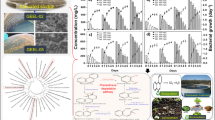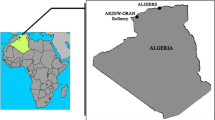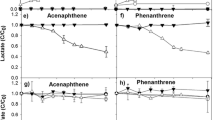Abstract
Biodesulfurization is a promising alternative for removing sulfur molecules from the polycyclic aromatic sulfur compounds (PASC) found in petroleum. PASC consists of recalcitrant molecules that can degrade fuel quality and cause a range of health and environmental problems. Therefore, identifying bacteria capable of degrading PASC is essential for handling these recalcitrant molecules. Microorganisms in environments exposed to petroleum derivatives have evolved specific enzymatic machinery, such as the 4S pathway associated with the dszABC genes, which are directly linked to sulfur removal and utilization as nutrient sources in the biodesulfurization process. In this study, bacteria were isolated from a bioreactor containing landfarm soil that had been periodically fed with petroleum for 12 years, using a medium containing dibenzothiophene (DBT), 4.6-dimethylbenzothiophene, 4-methylbenzothiophene, or benzothiophene. This study aimed to identify microorganisms capable of degrading PASC in such environments. Among the 20 colonies isolated from an inoculum containing DBT as the sole sulfur source, only four isolates exhibited amplification of the dszA gene in the dszABC operon. The production of 2-hydroxybiphenyl (HPB) and a decrease in DBT were detected during the growth curve and resting cell assays. The isolates were identified using 16S rRNA sequencing belonging to the genera Stutzerimonas and Pseudomonas. These isolates demonstrated significant potential for biodesulfurization and/or degradation of PASC. All isolates possessed the potential to be utilized in the biotechnological processes of biodesulfurization and degradation of recalcitrant PASC molecules.



Similar content being viewed by others
References
Abin-Fuentes A, Mohamed ME-S, Wang DIC, Prather KLJ (2013) Exploring the mechanism of biocatalyst inhibition in microbial desulfurization. Appl Environ Microbiol 79:7807–7817. https://doi.org/10.1128/AEM.02696-13
Ahmad A, Chauhan AK, Kushwaha HN et al (2015) Preferential desulfurization of dibenzyl sulfide by an isolated Gordonia sp. IITR100. 3 Biotech 5:237–243. https://doi.org/10.1007/s13205-014-0221-1
Akhtar N, Ghauri MA, Akhtar K (2016) Dibenzothiophene desulfurization capability and evolutionary divergence of newly isolated bacteria. Arch Microbiol 198:509–519. https://doi.org/10.1007/s00203-016-1209-5
Altschul SF, Gish W, Miller W et al (1990) Basic local alignment search tool. J Mol Biol 215:403–410. https://doi.org/10.1016/S0022-2836(05)80360-2
Bordoloi NK, Rai SK, Chaudhuri MK, Mukherjee AK (2014) Deep-desulfurization of dibenzothiophene and its derivatives present in diesel oil by a newly isolated bacterium Achromobacter sp. to reduce the environmental pollution from fossil fuel combustion. Fuel Process Technol 119:236–244. https://doi.org/10.1016/j.fuproc.2013.10.014
Buzanello EB, Rezende RP, Sousa FMO et al (2014) A novel Bacillus pumilus-related strain from tropical landfarm soil is capable of rapid dibenzothiophene degradation and biodesulfurization. BMC Microbiol. https://doi.org/10.1186/s12866-014-0257-8
Chandra Srivastava V (2012) An evaluation of desulfurization technologies for sulfur removal from liquid fuels. RSC Adv 2:759–783. https://doi.org/10.1039/C1RA00309G
Chen Z, Hu H, Xu P, Tang H (2022) Soil bioremediation by Pseudomonas brassicacearum MPDS and its enzyme involved in degrading PAHs. Sci Total Environ 813:152522. https://doi.org/10.1016/j.scitotenv.2021.152522
Davoodi-Dehaghani F, Vosoughi M, Ziaee AA (2010) Biodesulfurization of dibenzothiophene by a newly isolated Rhodococcus erythropolis strain. Bioresour Technol 101:1102–1105. https://doi.org/10.1016/j.biortech.2009.08.058
Derikvand P, Etemadifar Z, Biria D (2014) Taguchi optimization of dibenzothiophene biodesulfurization by Rhodococcus erythropolis R1 immobilized cells in a biphasic system. Int Biodeterior Biodegrad 86:343–348. https://doi.org/10.1016/j.ibiod.2013.10.006
dos Santos JMF, Casaes Alves PA, Silva VC et al (2017) Diverse genotypes of Bradyrhizobium nodulate herbaceous Chamaecrista (Moench) (Fabaceae, Caesalpinioideae) species in Brazil. Syst Appl Microbiol 40:69–79. https://doi.org/10.1016/j.syapm.2016.12.004
Duarte GF, Rosado AS, Seldin L et al (2001) Analysis of bacterial community structure in sulfurous-oil-containing soils and detection of species carrying dibenzothiophene desulfurization (dsz) genes. Appl Environ Microbiol 67:1052–1062. https://doi.org/10.1128/AEM.67.3.1052-1062.2001
Dube G, Osifo P, Rutto H (2014) Preparation of bagasse ash/CaO/ammonium acetate sorbent and modelling their desulphurization reaction. Clean Technol Environ Policy 16:891–900. https://doi.org/10.1007/s10098-013-0681-8
Feng S, Yang H, Zhan X, Wang W (2016) Enhancement of dibenzothiophene biodesulfurization by weakening the feedback inhibition effects based on a systematic understanding of the biodesulfurization mechanism by Gordonia sp. through the potential “4S” pathway. RSC Adv 6:82872–82881. https://doi.org/10.1039/C6RA14459D
Ghosh P, Mukherji S (2021) Growth kinetics of Pseudomonas aeruginosa RS1 on fluorene and dibenzothiophene, concomitant degradation kinetics and uptake mechanism. 3 Biotech 11:195. https://doi.org/10.1007/s13205-021-02742-7
Ismail W, El-Sayed WS, Abdul Raheem AS et al (2016) Biocatalytic desulfurization capabilities of a mixed culture during non-destructive utilization of recalcitrant organosulfur compounds. Front Microbiol. https://doi.org/10.3389/fmicb.2016.00266
Kilbane JJ (2006) Microbial biocatalyst developments to upgrade fossil fuels. Curr Opin Biotechnol 17:305–314. https://doi.org/10.1016/j.copbio.2006.04.005
Kodama K (1977) Induction of dibenzothiophene oxidation by Pseudomonas jiani. Agric Biol Chem 41:1193–1196. https://doi.org/10.1080/00021369.1977.10862662
Lalucat J, Gomila M, Mulet M et al (2022) Past, present and future of the boundaries of the Pseudomonas genus: Proposal of Stutzerimonas gen Nov. Syst Appl Microbiol 45:126289. https://doi.org/10.1016/j.syapm.2021.126289
Li W, Tang H, Liu Q et al (2009) Deep desulfurization of diesel by integrating adsorption and microbial method. Biochem Eng J 44:297–301. https://doi.org/10.1016/j.bej.2008.12.016
Maass D, Todescato D, Moritz DE et al (2015) Desulfurization and denitrogenation of heavy gas oil by Rhodococcus erythropolis ATCC 4277. Bioprocess Biosyst Eng 38:1447–1453. https://doi.org/10.1007/s00449-015-1386-7
Maciel BM, Dias JCT, dos Santos ACF et al (2007) Microbial surfactant activities from a petrochemical landfarm in a humid tropical region of Brazil. Can J Microbiol 53:937–943. https://doi.org/10.1139/W07-052
Martín-Cabello G, Terrón-González L, Santero E (2022) Characterization of a <scp> dszEABC </scp> operon providing fast growth on dibenzothiophene and construction of broad-host-range biodesulfurization catalysts. Environ Microbiol 24:1946–1963. https://doi.org/10.1111/1462-2920.15951
Matsui T, Hirasawa K, Konishi J et al (2001) Microbial desulfurization of alkylated dibenzothiophene and alkylated benzothiophene by recombinant Rhodococcus sp. strain T09. Appl Microbiol Biotechnol 56:196–200. https://doi.org/10.1007/s002530000549
Mohamed ME-S, Al-Yacoub ZH, Vedakumar J, v. (2015) Biocatalytic desulfurization of thiophenic compounds and crude oil by newly isolated bacteria. Front Microbiol. https://doi.org/10.3389/fmicb.2015.00112
Mohebali G, Ball AS (2016) Biodesulfurization of diesel fuels—past, present and future perspectives. Int Biodeterior Biodegrad 110:163–180. https://doi.org/10.1016/j.ibiod.2016.03.011
Monticello DJ (2000) Biodesulfurization and the upgrading of petroleum distillates. Curr Opin Biotechnol 11:540–546. https://doi.org/10.1016/S0958-1669(00)00154-3
Nejad NF, Beigi AAM (2015) Efficient desulfurization of gasoline fuel using ionic liquid extraction as a complementary process to adsorptive desulfurization. Pet Sci 12:330–339. https://doi.org/10.1007/s12182-015-0020-2
Nuhu AA (2013) Bio-catalytic desulfurization of fossil fuels: a mini review. Rev Environ Sci Biotechnol 12:9–23. https://doi.org/10.1007/s11157-012-9267-x
Shavandi M, Sadeghizadeh M, Zomorodipour A, Khajeh K (2009) Biodesulfurization of dibenzothiophene by recombinant Gordonia alkanivorans RIPI90A. Bioresour Technol 100:475–479. https://doi.org/10.1016/j.biortech.2008.06.011
Singh SP, Schwan AL (2011) Sulfur Metabolism in Plants and Related Biotechnologies. In: Comprehensive Biotechnology. Elsevier, pp 257–271
Soleimani M, Bassi A, Margaritis A (2007) Biodesulfurization of refractory organic sulfur compounds in fossil fuels. Biotechnol Adv 25:570–596. https://doi.org/10.1016/j.biotechadv.2007.07.003
Stanislaus A, Marafi A, Rana MS (2010) Recent advances in the science and technology of ultra low sulfur diesel (ULSD) production. Catal Today 153:1–68. https://doi.org/10.1016/j.cattod.2010.05.011
Tamura K, Stecher G, Kumar S (2021) MEGA11: molecular evolutionary genetics analysis Version 11. Mol Biol Evol 38:3022–3027. https://doi.org/10.1093/molbev/msab120
Tang K, Hong X, Zhang Y et al (2010) Adsorptive desulfurization on a heteroatoms Y zeolite prepared by secondary synthesis. Sci China Chem 53:281–286. https://doi.org/10.1007/s11426-010-0037-8
Wang J, Butler RR, Wu F et al (2017) Enhancement of microbial biodesulfurization via genetic engineering and adaptive evolution. PLoS ONE 12:e0168833. https://doi.org/10.1371/journal.pone.0168833
Winkler JD, Kao KC (2014) Recent advances in the evolutionary engineering of industrial biocatalysts. Genomics 104:406–411. https://doi.org/10.1016/j.ygeno.2014.09.006
Xu Y, Zhou N-Y (2017) Microbial remediation of aromatics-contaminated soil. Front Environ Sci Eng 11:1. https://doi.org/10.1007/s11783-017-0894-x
Zhang M, Li A, Yao Q et al (2022) Pseudomonas oligotrophica sp nov, a novel denitrifying bacterium possessing nitrogen removal capability under low carbon-nitrogen ratio condition. Front Microbiol. https://doi.org/10.3389/fmicb.2022.882890
Funding
This study was supported by the National Council for Scientific and Technological Development (CNPq). The authors were funded by the Coordenação de Aperfeicoamento de Pessoal de Nível Superior (CAPES), finance code 001.
Author information
Authors and Affiliations
Contributions
All authors contributed to the study conception and design. Material preparation, data collection and analysis were performed by GMN, ELSM and LKSO. Data curation was performed by all authors. Funding resources was acquired by RPR and JCTD. The first draft and revised version of the manuscript was written by GMN and ELSM. All authors commented on previous versions of the manuscript. All authors read and approved the final manuscript.
Corresponding author
Ethics declarations
Conflict of interest
All authors declare that they have no conflict of interest.
Additional information
Communicated by Yusuf Akhter.
Publisher's Note
Springer Nature remains neutral with regard to jurisdictional claims in published maps and institutional affiliations.
Supplementary Information
Below is the link to the electronic supplementary material.
Rights and permissions
Springer Nature or its licensor (e.g. a society or other partner) holds exclusive rights to this article under a publishing agreement with the author(s) or other rightsholder(s); author self-archiving of the accepted manuscript version of this article is solely governed by the terms of such publishing agreement and applicable law.
About this article
Cite this article
Matos Neto, G., Marques, E.L.S., Oliveira, L.K.S. et al. Searching for bacteria able to metabolize polycyclic aromatic sulfur compounds in 12-years periodically fed bioreactor. Arch Microbiol 205, 336 (2023). https://doi.org/10.1007/s00203-023-03674-x
Received:
Revised:
Accepted:
Published:
DOI: https://doi.org/10.1007/s00203-023-03674-x




